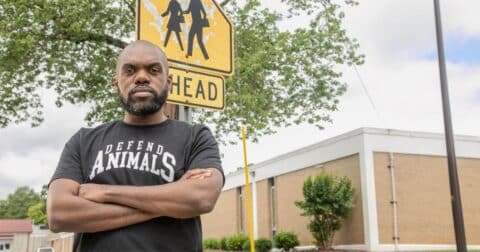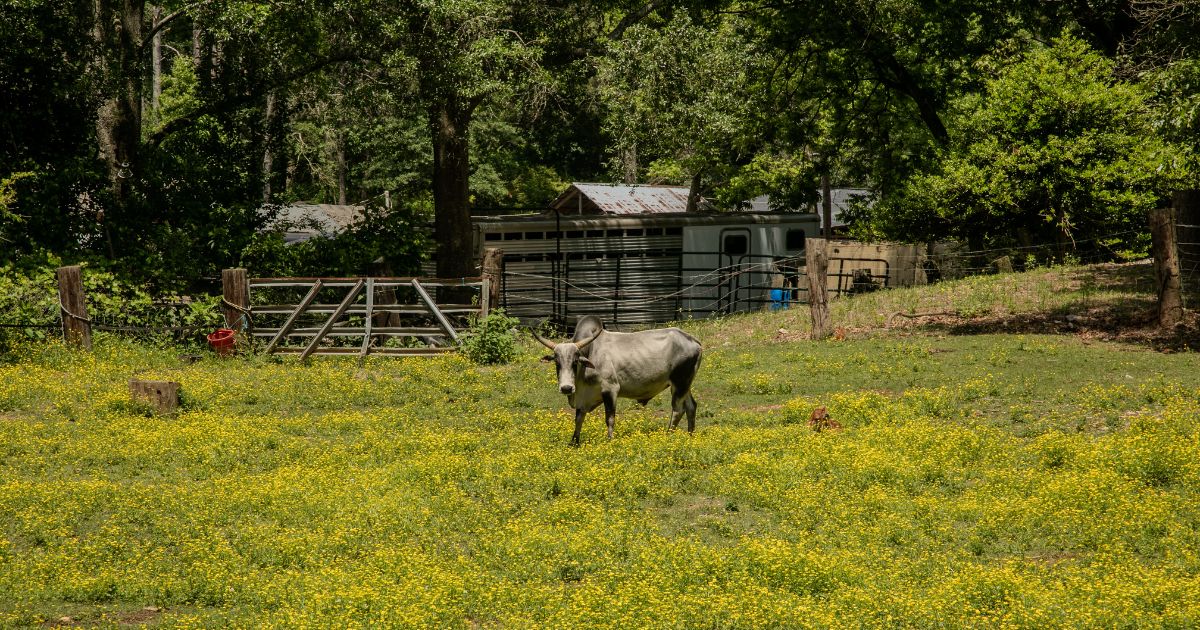News
Tyson Foods Decides to Drop ‘Climate-Smart’ Beef Label
Legal Action•5 min read
Solutions
Why focusing on zoning regulations and inclusivity is a path forward for activists.


Words by Grace Hussain
In April 2019, Chris Eubanks, head of the animal rights group Apex Advocacy, chanted along with a group of other activists in front of the city government building in Lithonia, Georgia. The local activists had been campaigning to shut down Bradford’s Livestock — a backyard slaughterhouse operated in the center of their small, predominantly Black community — since 2014. Eubanks joined in 2021, lending Apex’s resources and giving the campaign a highly needed energy boost. Right down the street from the public school and around the block from a church, the facility killed roughly 100 animals every month.
Though local to the area, Eubanks had been completely unaware of the campaign. “I’ve been doing this for years,” he tells Sentient. Yet the presence of the backyard slaughterhouse in the small Atlanta suburb caught even Eubanks by surprise. “I didn’t realize that there was a slaughterhouse five minutes from where I live[d].”
Late last year, the coalition finally accomplished their goal, thanks in part to Apex Advocacy. For Eubanks, his prior lack of awareness that there was a slaughterhouse in his backyard is indicative of a larger issue within the animal rights movement: not paying close enough attention to Black and Brown communities, and the issues they face.
By the time Eubanks entered the picture, community activists like Jan Costello had already been campaigning for years. In addition to her activism, Costello was working with the community development corporation at the time, encouraging new businesses to move to the area. Despite activists’ dedication, they struggled to overcome the numerous roadblocks they faced, largely due to a lack of time and resources to dedicate toward their campaign — the two things Apex Advocacy was poised to provide.
In the years before Eubanks got involved, local activists attended council meetings, maintained an email list of more than 1,000 community members, kept meticulous records of exactly what the facility was doing and spoke to neighbors about the slaughterhouse operating in their backyards, says Costello. Their tactics relied heavily on the fact that the slaughterhouse was violating zoning laws by being located in a residential neighborhood.
Their efforts helped get the facility slapped with a cease and desist order from the county’s Department of Planning in 2019, but because the facility had a license from the state’s Department of Agriculture, it continued to operate, killing thousands more animals.
When Eubanks saw coverage of the situation on a local news channel, he knew he had to help. The news segment made it look like locals were “trying to take advantage of a small, Black business owner,” says Eubanks, and there was much more going on. “The news coverage didn’t help as much as the advocates in the community thought it would.”
What it did do was grab Eubanks’ attention, leading him to reach out to Costello.
“He brought in so much energy and advocacy at a point when we were just basically doing the same old thing,” Costello says. By leveraging Apex Advocacy’s network, the activists were able to flood officials’ emails with thousands of messages. “Although we got support from the outside, the foundation was community-based,” says Eubanks.
Despite most of the core group of advocates being animal rights activists, “we were just focusing on the zoning aspect of the law,” says Costello. “We were very careful not to turn this into an argument about the slaughtering of animals for consumption,” she continues, “because that wasn’t the law. [Bradford] could do that business, but just not there in the neighborhood.”
The major roadblock to their success came via the very legal system they relied upon to shutter the slaughterhouse due to zoning violations. Part of the problem was that the state issued the facility a license to operate as a custom exempt processing facility — meaning they couldn’t sell meat. “The slaughterhouse owner was able to use the loophole that he wasn’t selling meat, but selling the service of killing animals,” says Eubanks.
As critics pointed out, the facility was in fact offering entire animals for sale via Facebook. While the license didn’t remedy the local zoning problem, it did lend some legitimacy to the slaughterhouse’s operations — a fact the facility took full advantage of.
In response to the 2019 cease and desist order from the county, Bradford’s Livestock sued in 2020, arguing they had the right to use the land the way they saw fit. The legal team did their best to drag the case out as long as possible by repeatedly filing for extensions — an effort made easier by COVID. Dekalb county filed a motion to dismiss the lawsuit in June 2020.
While the case was decided, the slaughterhouse continued to operate, killing thousands more animals, according to the activists’ records. “When you’re trying to advocate for something that’s right, and it takes that long to get action, you create and breed cynicism in your group of supporters,” says Costello.

Eubanks suspects his joining the campaign leant it additional legitimacy within the community. “I think it was an opportunity to show that this isn’t a group of white people attacking a Black business, because that was the narrative beforehand,” he says.
Still, one factor that Eubanks believes heavily influenced the lack of urgency to get the slaughterhouse closed was race. Lithonia is “a small, Black community,” says Eubanks. “We really do believe that if this had been another community, a more affluent community, it would have definitely been shut down,” he says. “If this had been a more powerful community this would have been an issue that was shut down immediately.”
The lack of attention paid to Black and Brown communities has been an issue for social movements for generations. Environmental groups often ignore Indigenous communities, feminists often ignore Black women and animal rights advocates often overlook slaughterhouses in majority-Black neighborhoods.
“The animal rights community needs to make sure that we are not operating in a bubble and that we are pulling in the people,” Eubanks says. In recent years, the animal rights movement has shifted toward paying more attention to inclusion, with many organizations being more intentional about issues of equity and justice in how they allocate their resources.
Meanwhile, recent research suggests that animal-centered protests may actually backfire, leading some activists to shift towards putting the emphasis on arguments other than animal rights — such as zoning laws.
Part of the evolving movement is also about increasing buy-in from Black and Brown communities. Apex recently launched a movement guide on why food systems issues are specifically important to marginalized racial groups, and if animal rights groups want to be more effective, they’d be wise to take note.
This story is part of a series called How Food Justice is Made: Stories and Solutions, in which Sentient dives into four different communities, and the unique ways they’re combatting slaughterhouses.